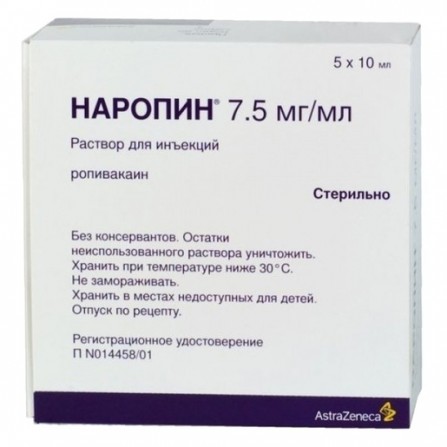Naropin injection solution 7.5mg ml 10ml ampoules N5
Condition: New product
1000 Items
Rating:
Be the first to write a review!

More info
Active ingredients
Ropivacaine
Composition
1 ml of 1 amp. ropivacaine hydrochloride 7.5 mg 75 mg. Excipients: enteric pellets - sugar spheres (sucrose content not more than 92%), hyprolose (hydroxypropyl cellulose), hypromellose, magnesium heavy carbonate, copolymer of methacrylic acid and ethyl acrylate (1: 1) dispersion of 30%, triethyl citrate, talc, titanium dioxide, sodium carboxymethylcellulose, macrogol, sodium hydroxide. extended release pellets - sugar spheres (sucrose content not more than 92%), ammonium methacrylate copolymer (type A), ammonium methacrylate copolymer (type B), hyprolose (hydroxypropylcellulose), triethyl citrate, talc. The composition of the contents of the capsule: enteric pellets, slow-release pellets, talc *. The composition of the capsule body: gelatin (EP), titanium dioxide (E171). The composition of the capsule cap: gelatin (EP), titanium dioxide (E171), indigo carmine dye FD & C Blue 2 (E132).
Pharmacological effect
Local anesthetic amide type. Causes anesthesia and has an analgesic effect. In high doses, it causes surgical anesthesia, and in lower doses, it blocks sensitivity with a limited non-progressive motor blockade. The mechanism of action is associated with a reversible decrease in the permeability of the nerve fiber membrane for sodium ions. As a result, there is a decrease in the depolarization rate and an increase in the excitability threshold, which leads to a local blockade of nerve impulses. With a significantly higher dose, it has a depressant effect on the central nervous system and myocardium (reduces excitability and automatism, worsens conductivity). Ropivacaine is characterized by prolonged action. The duration of anesthesia depends on the dose and route of administration, but does not depend on the presence of a vasoconstrictor.
Indications
Anesthesia for surgical interventions: epidural blockade for surgical interventions, including cesarean section. blockade of large nerves and nerve plexuses. blockade of individual nerves and local infiltration anesthesia. Relief of acute pain syndrome: long-term epidural infusion or intermittent bolus administration, for example, to eliminate postoperative pain or pain relief in childbirth. blockade of individual nerves and local infiltration anesthesia.
Contraindications
Children age up to 12 years, hypersensitivity to local anesthetics amide type.
Use during pregnancy and lactation
Use during pregnancy is possible in cases where the potential benefits of maternal therapy outweigh the existing risk to the fetus. There is evidence of the absence of negative effects when ropivacaine is used in obstetrics for anesthesia or analgesia. Ropivacaine penetrates well through the placental barrier. Plasma protein binding is lower in the fetus than in the mother. If necessary, use during lactation should take into account that a small amount of ropivacaine is excreted in breast milk.
Dosage and administration
Dose set individually depending on the evidence, the clinical situation, the patient's condition.
Side effects
Allergic reactions: skin manifestations, anaphylactic shock. Most of the side effects that occur during anesthesia are not associated with the effect of the anesthetic used, but with the technique of regional anesthesia. Most often (more than 1%) the following adverse effects were noted, which were regarded as having clinical significance regardless of whether a cause-effect relationship was established using anesthetic. Since the cardiovascular system: arterial hypertension, arterial hypotension, bradycardia, tachycardia. On the part of the digestive system: nausea, vomiting. From the side of the central nervous system and peripheral nervous system: headache, dizziness, paresthesia. Neuropathy and dysfunction of the spinal cord (anterior spinal artery syndrome, arachnoiditis) are usually associated with the technique of regional anesthesia, and not with the action of ropivacaine. Other: fever, chills, urinary retention.
special instructions
Allergic reactions: skin manifestations, anaphylactic shock. Most of the side effects that occur during anesthesia are not associated with the effect of the anesthetic used, but with the technique of regional anesthesia. Most often (more than 1%) the following adverse effects were noted, which were regarded as having clinical significance regardless of whether a cause-effect relationship was established using anesthetic.Since the cardiovascular system: arterial hypertension, arterial hypotension, bradycardia, tachycardia. On the part of the digestive system: nausea, vomiting. From the side of the central nervous system and peripheral nervous system: headache, dizziness, paresthesia. Neuropathy and dysfunction of the spinal cord (anterior spinal artery syndrome, arachnoiditis) are usually associated with the technique of regional anesthesia, and not with the action of ropivacaine. Other: fever, chills, urinary retention.


